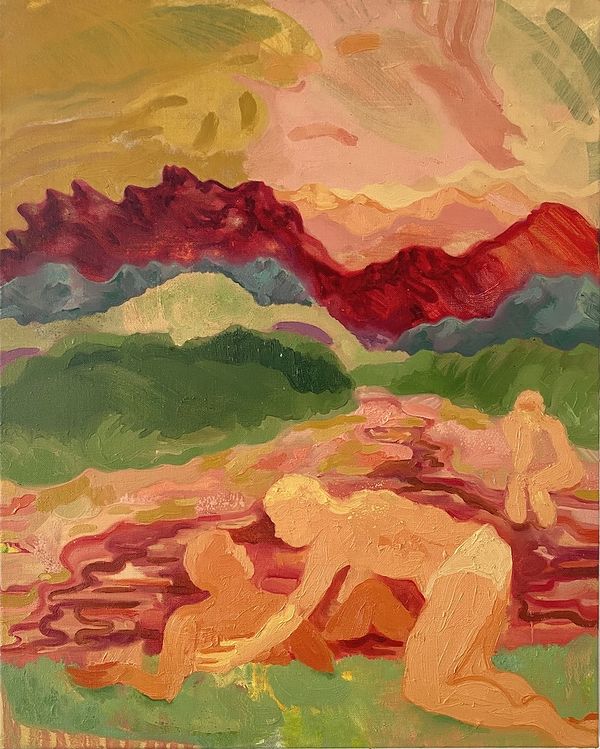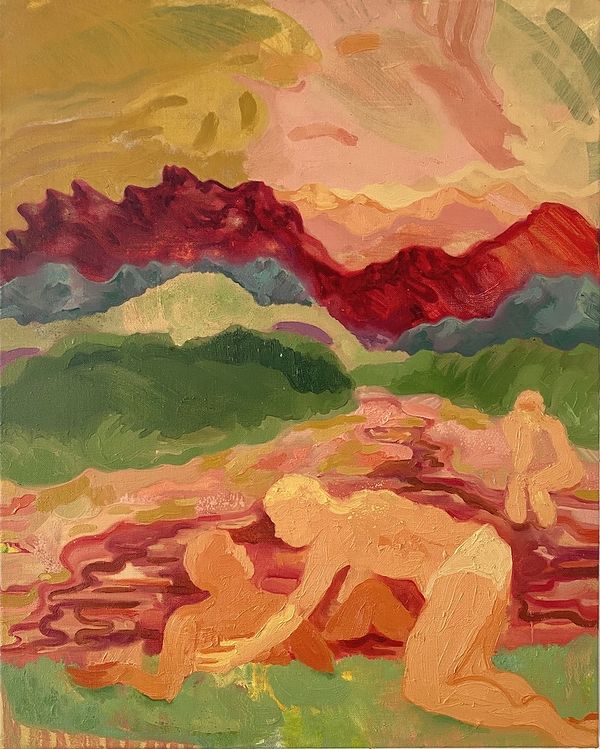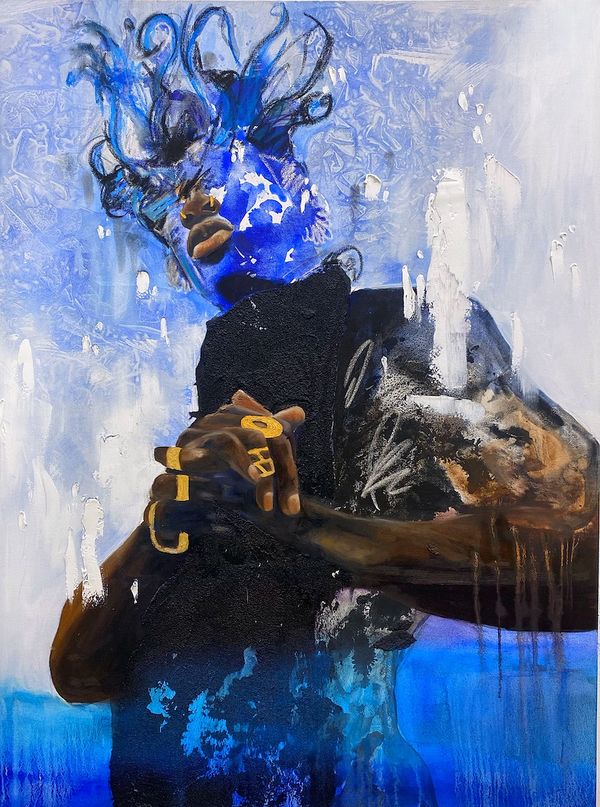Antonia Showering, Who do you follow?, 2021. Oil on linen. 51 x 41 x 2 cm (20.08 x 16.14 x 0.8 in). Signed and dated on the reverse. Donation courtesy of the artist. Photography courtesy of the artist.
Since 2014, Whitechapel Gallery’s Art Icon gala and auction has raised funds for educational and community programming—and over the years, the funds have supported tens of thousands of children, students, and families. For its latest iteration, Whitechapel Gallery has teamed up with Phillips to auction eleven contemporary artworks by leading artists such as Jadé Fadojutimi, Ilse D'Hollander, Donna Huanca, Rachel Jones, Wonder Buhle Mbambo, Cassi Namoda, Ernesto Neto, Yinka Shonibare CBE, Antonia Showering, Khari Turner, and Flora Yukhnovich.
To coincide with the online auction, we spoke with some of the artists—Cassi Namoda, Antonia Showering, Khari Turner—to learn more about the works they are contributing. Read on to learn more about the artworks, their makers, and the ideas, themes, and visions that inspired them, from Alexander McQueen to invisibility, from quarantine to non-platonic love.
Cassi Namoda
Cassi Namoda, Princess Elizabeth Bagaya of Toro, 2021. Oil on cotton poly. 100.3 x 81.3 cm (40 x 32 x 2 in). Signed. Donation courtesy of the Artist and Goodman Gallery. Photography by Jenny Gorman.
How did you become involved with Whitechapel Gallery Art Icon?
The prestigious award will be given to artist Yinka Shonibare, who is an artist I have greatly admired for many, many years. I have deep respect for him. My representative gallery, Goodman Gallery, shared the wonderful news and kindly asked if I would like to get involved and mentioned the brilliant incentive behind it.
Could you tell us about your work, Princess Elizabeth Bagaya of Toro?
During the midst of the pandemic, I read Princess Elizabeth Bagaya of Toro’s autobiography. I was deeply captured by her intellect and diplomacy—not to mention her undying love for her country and her style and grace. These are the qualities I praise and admire, so when asked to take part in Vogue Italia's March 2021 issue on who inspires me, I had to pay homage to this stunning human being; her life was full of trials and she persevered.
Even in her efforts to appear as a local market woman, she still reveals a regality about her that everyone seems to notice.
Why did you choose the Alexander McQueen dress?
Alexander McQueen is an iconic British designer; his legacy left behind in the world of design and couture must never be forgotten. I imagined McQueen would have loved to dress someone like Princess Elizabeth Bagaya of Toro. So, when asked to choose a contemporary fashion to place on the Princess figure, given her history of diplomatic work in the commonwealth and her studies in UK, I naturally saw this to be a good fit, especially as the Princess loves her fashion.
This painting has so many layers to it—it’s almost infused with its own consciousness. What initially inspired it? Was it first through an interest in depicting Princess Elizabeth Bagaya of Toro or did her image emerge later on in your process?
This is a historical painting in its essence. I read that Princess Elizabeth Bagaya when she finally decided to escape the threat of Idi Amins Uganda traveled intensely to get to the border of Kenya/ Uganda and had to walk many miles to get to the nearest town. I saw an image that depicted the Princess in “normal” African dressing carrying a stack of bananas as to appear as a market woman. The bystanders observe her as if she was not an ordinary lady, so even in her efforts to appear as a local market woman, she still reveals a regality about her that everyone seems to notice.
The gala raises funds for community education and programming—why are these programs meaningful to you?
I stand for community incentives that strive to build a better landscape for the welfare of its citizens. This gala just simply falls in alignment with ideology.
Antonia Showering
Antonia Showering, Who do you follow?, 2021. Oil on linen. 51 x 41 x 2 cm (20.08 x 16.14 x 0.8 in). Signed and dated on the reverse. Donation courtesy of the artist. Photography courtesy of the artist.
How did you become involved with Whitechapel Gallery Art Icon?
Whitechapel Gallery’s annual Art Icon auction has been on my periphery for quite a few years, as a friend donated one of his paintings when I had just started at the Slade. Around last Christmas (feeling far from festive in light of the past year we have all just endured) I saw my phone light up and it was Iwona Blazwick inviting me to be a part of the auction, it was a very special thing to hear at the end of this tough, lonely year.
Could you tell us about Who do you follow?
This painting was made especially for Whitechapel Gallery, it is an usual scale for me (51 x 41 cm). The painting depicts two figures about to engage or perhaps already engaging in an act of intimacy. I enjoy how there’s just enough information for the viewer to create their own interpretation drawn from the given imagery. The landscape is taken from a place (before Covid) I return to regularly. Recently, I find myself almost obsessively painting this place because of my deep yearning to go back.
The work is reminiscent of the canon of bathers’ paintings—were there specific artists that you were reflecting on as you worked?
I try to avoid reflecting too heavily on one artist or artwork whilst I’m in the midst of making a work, as it can become too loud in the studio, but I do have a wall covered in images that ignite or move something in me—Alice Neel, Henry Taylor, Etel Adnan, Ken Kiff, Lynette Yiadom-Boakye, Helen Frankenthaler, John Hoyland and Paul Sérusier to name but a few. Sérusier’s use of color is what first led me to his practice but interestingly, in answer to your question, his bathing scenes hold a lot of magic that really speak to me. Watching adults immerse themselves into water, becoming weightless for a moment, seems to reveal an infantile playfulness in even the most prudent. There’s also a vulnerability exposed during these times, perhaps through our nakedness and how we struggle to maneuver ourselves in water, that makes us behave or connect with one another differently.
Watching adults immerse themselves into water, becoming weightless for a moment, seems to reveal an infantile playfulness in even the most prudent.
Your work often explores layers of recollection and relationships that open themselves to viewers’ projections. Could you tell me a bit more about this relationship to the viewer?
My brother, my mother or my partner may inhabit the canvases but they act as universal figures. I want these characters to represent a brother, a mother or a partner enabling me to tap into more collective human relationships. The inspiration in my work stems from very personal lived moments and whilst no two people have undergone the same experience, the emotions emitted are pervasive. I want my paintings to harness these and to try and make them tangible with paint. Eventually we all, at some point in our lives, go through major, universal moments that form us as people; feeling non-platonic love for the first time and maybe the heartache that follows, having children or maybe never having a child, endlessly ruminating over regrets and the excitement of something just beginning. I try to make my understanding of these ubiquitous moments concrete with paint, describing the figures without too much specificity so others can hopefully feel something from my work and recognize themselves within it to a certain degree.
The gala raises funds for community education and programming—why are these programs meaningful to you?
I think after the year we just had there hasn’t been a more important time to be contributing to such a meaningful program. I have visited Whitechapel Gallery many times and seen some awe-inspiring shows from the recent Kai Althoff goes with Bernard Leach and Radical Figures to the Eduardo Paolozzi. Their displays, commissions, and archive galleries are free with two ticketed exhibitions a year supporting their exhibition and education programs, and I feel glad to also be contributing to this too. They hold a wide range of workshops, residencies, and projects to try and engage children in the art world, from the outside art institutions could appear to be quite daunting places. I was lucky enough to have a grandmother who taught history of art, and I found her encouragement to share her world with me very formative. I know not everyone is fortunate enough to be exposed to exhibitions from a young age and I really respect Whitechapel Gallery’s education programs that try to tackle this. Even if the canvas I donated means one child seeing a piece of art that moves them, I will feel it was a success.
Khari Turner
Khari Turner, Moonlit King, 2021. Acrylic, oil, charcoal, san, ocean water, Milwaukee river water, Lake Michigan water, water from southern Manhattan harbor on canvas. 121.92 x 96.52 x 3.81 cm (48 x 38 x 1.5 in). Signed on verso. Donation courtesy the artist and Ross-Sutton Gallery.
How did you become involved with Whitechapel Gallery Art Icon?
I came into contact while searching for artists and past experiences they had with Whitechapel. With this current opportunity, it was all due to the amazing Destinee Ross-Sutton for reaching out and helping out with this.
Can you tell us about Moonlit King?
Moonlit King was inspired by an image of Moses Sumney shot by Breyona Holt. I saw the pose and really enjoyed the way the figured placed themselves above the viewer. In my interpretations of this work, I saw that figure taking on a godlike state and the use of gold and the clasping of the hands as the move to raise water to form waves. This piece doesn’t have a sound attached, but I wanted the marks and lifts of paint to feel like a splash and act of dripping water from this wave created by the figure. This while the crown was drawn and the idea of my hand gracing this character with royalty as I see it.
Could you tell us more about how the moment we’re in affected Moonlit King?
This moment is so strange because there is so much time devoted to the self and its immediate environment. This idea of the ocean and the Black body came about as life follows water. Being in NY and growing up in Milwaukee, WI, next to Lake Michigan, you cling to this aspect of life. I think about history often in connecting to my place here and water is a large part of that journey. This comes with any lineage that travels back to slavery and the last name of Turner. Moonlit King was an inspiration of my ideas of the Black bodies left in the ocean becoming masters of the ocean and breathing new life into the lives of Black people surrounded by this water.
I imagine these images as beautiful renditions of that unwillingness to allow themselves to drown.
Your work often explores identifiably Black features, as in Moonlit King, where the body ripples away and facial features, hands, and jewelry are foregrounded. Can you tell us about the relationship between visibility and invisibility, hard and soft?
This idea of the visible and invisible is a direct relationship to the body and water. The body is made up of water mainly. This body also acts a certain way once placed into a large body of work. This can be also a metaphor in the way Black bodies are seen and not seen. When you dip your head into water the last things to enter the water are the nose and the lips in a way. That last grab for life and air until you sink in. I wonder in which way that contrasts with life above water. The term drowning isn’t only associated with water, some are drowning in debt. I feel like there is more to unpack there, but I imagine these images as beautiful renditions of that unwillingness to allow themselves to drown. To be glorious. To connect the fact that these images are made of water like a real body and those real bodies don’t need eyes to look into the soul of the viewer, but the abstraction allows for an internal view of one’s own identity or self.
The gala raises funds for community education and programming-why are these programs meaningful to you?
This is such a large part of my upbringing. I am only here now because of the grace that art, and the people involved with art, have given me. Milwaukee is not a very safe place outside of the east and west side. The ideas of “making it out” are notable phrases used to describe this. It is reflected in every aspect of breaking from a predetermined future of bondage and being a hostage to circumstances. Notably a non-profit called Lake Valley Camp in Milwaukee, brought me to believing in myself and seeing myself as more than another kid. I plan to bring this same future to the kids who grew up like me and to give back as I can to change some of these issues I faced.
Discover More from Whitechapel Gallery Art Icon >
Recommended Reading
When Black People Dream, What Do They Dream About? >
How Genieve Figgis Inspired ‘Bridgerton’ >




